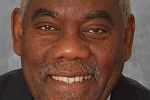By Dr Selwyn R. Cudjoe
July 26, 2025
 Today, we have come to bury our black prince in this place where he was born, lived, and died. In gathering here, in St Mary’s Anglican Church, Tacarigua, the second oldest Anglican church in the island, we come to honour the life, legacy, and work of Ulric “Buggy” Haynes. I can think of no better description of our beloved brother than the words Ossie Davis delivered at Malcolm X’s home-going in 1965.
Today, we have come to bury our black prince in this place where he was born, lived, and died. In gathering here, in St Mary’s Anglican Church, Tacarigua, the second oldest Anglican church in the island, we come to honour the life, legacy, and work of Ulric “Buggy” Haynes. I can think of no better description of our beloved brother than the words Ossie Davis delivered at Malcolm X’s home-going in 1965.
Davis said: “Here—at this final hour, in this quiet place—Harlem [we will say Tacarigua] has come to bid farewell to one of its brightest hopes, extinguished now, and gone from us forever. For Harlem [Tacarigua] is where he worked and where he struggled and fought—his home of homes, where his heart was, and where his people are—and is, therefore fitting that we meet once again, in Harlem [Tacarigua] to share these last moments with him.”
Ulric “Buggy” Haynes was born on December 12, 1948, to Constance Waterman and Denzel Haynes. Buggy lived opposite to my home on Bailey Street, Tacarigua, all of his life. His grandparents, Joseph and Miriam Waterman, emigrated from Barbados to Trinidad. They raised their six children, Boyse, Bebe, Constance, Maude, Carmen and Violet, in what was then called “the sleepy village of Tacarigua”.
Tacarigua was an agricultural district. Apart from his cultivation of ground provisions such as sweet potatoes, cassava, eddoes and dasheens, Joseph also rented large plots of land from the Orange Grove Sugar Estate, where he cultivated sugar canes that he sold to the estate each year.
Constance was first married to Evans Philip, from which came several children. Buggy’s elder brothers from that marriage, Clyde, Carlton and Kelvin, assisted their grandfather in cultivating his sugar cane crops. My mother, Carmen Cudjoe, was Clyde’s godmother. Clyde taught me at Tacarigua EC and I, in turn, taught Buggy at the same school.
Around 1940 Constance married Denzel Haynes. Seven children came out of that union: Edwin, Mavis, Audrey, Buggy, Enric, Oswald and Michael, whose son Mark is one of the officiating pastors today.
In the 1950s, we played cricket at the side of Buggy’s home and in the adjacent streets with Buggy’s father and Sonny Frasier, his uncle, from whom he learned his cricket. Buggy was an excellent cricketer. He was a standout in any sport he played: cricket, football or table tennis. He was not particularly academically brilliant, but he was a passionate and determined person, qualities that manifested themselves in all the endeavours he undertook.
Buggy possessed exceptional football skills which he honed on the Holy Ground Savannah on the western side of Tacarigua EC. At the age of 15, Buggy played football for Tacarigua EC Ex-Pupils with districkers such as Eddie Hart and George Jordan. This meant that he played with footballers who were older than him. Then he went on to play in the East St George League in St Joseph and the Arima Football League in the inter-zone competition in 1963 and 1964, respectively.
Buggy’s path was accelerated when Hart, another brilliant son of Tacarigua and former parliamentarian, took him to the Big Yard in Port of Spain to play for Malvern Sports Club, where he excelled. He was selected to play for T&T’s national football team which he eventually captained. He called his captaincy of the national team “the greatest honour of my life”. He played for Malvern and the Tacarigua EC Ex-Pupils until 1977.
After his active playing days, Buggy devoted himself to giving back to his community. In 1988, he opened the Ulric “Buggy” Haynes Coaching School, where he trained boys and girls in cricket and football. Many of his pupils went on to perform for the country at the junior and senior levels. With the help of his brother, Oswald, and other friends, they also trained young people in track and field.
Although these sporting endeavours played an important part in Buggy’s life, his greatest accomplishment came when he led the charge to prevent the former People’s Partnership (PP) government from taking over the Orange Grove Savannah (at present known as the Eddie Hart Grounds).
The PP had planned to build a stadium, a swimming pool for “elite” athletes on what is now known as the “Buggy Haynes Ground”, and a car park to accommodate 346 cars on the Dinsley Grounds. Those are the structures one would have seen on these grounds if Buggy hadn’t intervened decisively.
Buggy realised the districkers would lose a cherished sporting and cultural area that our forefathers and foremothers used for centuries. At that time, more than 1,500 people from as far afield as Arima and St Joseph used these playing fields daily. Thanks to Buggy, more people use that ground today.
